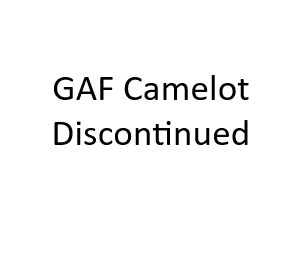In the world of roofing, GAF has long been a trusted name, known for its quality products and innovation. One of its iconic shingle lines, the GAF Camelot, has been a popular choice among homeowners and roofing professionals for years. However, in recent times, there has been a significant development in the roofing industry that has left many surprised and curious. The GAF Camelot has been discontinued, marking the end of an era. In this blog post, we will explore the reasons behind this decision, the impact on the roofing industry, and what homeowners and contractors can expect in the future.
The Legacy of GAF Camelot
Before delving into the discontinuation of the GAF Camelot, let’s take a moment to appreciate the legacy of this beloved shingle line. The Camelot series was renowned for its exceptional aesthetics and durability. It was a top choice for those seeking a premium roofing option that not only protected their homes but also enhanced their curb appeal.
The GAF Camelot shingles were known for their unique design, which mimicked the look of natural slate or wood shakes. This gave homeowners the opportunity to achieve a high-end, sophisticated appearance for their roofs without the cost and maintenance associated with traditional materials. The Camelot series was available in various colors and styles, allowing homeowners to choose the perfect option to match their home’s architecture.
Reasons for Discontinuation
So, what led to the discontinuation of such a beloved product? Several factors contributed to this decision by GAF:
- Evolving Market Demands: The roofing industry is constantly evolving, with homeowners and contractors seeking new features and technologies. GAF made the decision to reallocate resources towards developing innovative roofing solutions that better align with current market demands.
- Environmental Concerns: In recent years, there has been an increased focus on sustainability and environmentally friendly roofing options. While the GAF Camelot was a high-quality product, it may not have met the sustainability criteria that are becoming increasingly important to consumers.
- Competitive Landscape: The roofing market is highly competitive, with many manufacturers introducing new products and technologies. GAF needed to stay competitive by offering cutting-edge solutions that meet the changing needs of customers.
Impact on the Roofing Industry
The discontinuation of the GAF Camelot has had a significant impact on the roofing industry. Contractors who were accustomed to using these shingles for their premium projects had to adapt to new product lines. Homeowners looking to replace their roofs with Camelot shingles had to explore alternative options.
One of the key takeaways from this development is that the roofing industry is always in flux. Manufacturers like GAF must continuously innovate to stay relevant and meet the evolving demands of customers. This serves as a reminder to homeowners and contractors alike that staying informed about new roofing products and technologies is essential to making the best choices for their projects.
What’s Next for Homeowners and Contractors?
If you were a fan of the GAF Camelot shingles, fear not, as there are plenty of other high-quality roofing options available. Manufacturers are continually introducing new and improved products that offer durability, aesthetics, and energy efficiency.
For homeowners, it’s essential to work with experienced roofing contractors who can help you select the right shingles for your home. These professionals are well-versed in the latest roofing technologies and can guide you in making an informed decision.
For contractors, staying up-to-date with the latest roofing trends and products is crucial. Embracing new technologies and sustainable roofing solutions can help you stand out in a competitive market and meet the changing preferences of homeowners.
In the wake of the GAF Camelot’s discontinuation, let’s explore some alternative roofing options that homeowners and contractors can consider:
- Architectural Shingles: Architectural shingles are a popular choice for homeowners seeking a blend of durability and aesthetics. These shingles come in various styles and colors, offering a range of design possibilities. They are known for their dimensional appearance, mimicking the texture of wood shakes or slate.
- Designer Shingles: If you’re looking to make a bold statement with your roof, designer shingles might be the way to go. These premium shingles often feature intricate designs and unique color options, allowing homeowners to create a truly distinctive look for their homes.
- Energy-Efficient Shingles: With a growing emphasis on energy efficiency, many roofing manufacturers now offer shingles designed to improve a home’s energy performance. These shingles can help regulate indoor temperatures and reduce heating and cooling costs.
- Sustainable Roofing Materials: For environmentally conscious homeowners, exploring sustainable roofing materials is a great option. This includes materials like metal roofing, which is highly durable and recyclable, and solar roofing, which harnesses solar energy to power homes.
- Synthetic Roofing Materials: Synthetic roofing materials, such as synthetic slate or wood shakes, offer the aesthetic appeal of natural materials without the associated maintenance and cost. They are often more durable and weather-resistant than their natural counterparts.
- Consult with a Professional: When considering a new roof, it’s crucial to consult with a roofing professional. They can assess your specific needs, budget, and design preferences to recommend the most suitable roofing material for your home.
- Stay Informed: Homeowners and contractors should stay informed about the latest roofing trends and innovations. Subscribe to industry publications, attend trade shows, and engage with reputable roofing manufacturers to keep up with the latest developments.
In conclusion, while the discontinuation of the GAF Camelot shingles may have been a surprise to many, it underscores the need for flexibility and adaptation in the roofing industry. New and exciting roofing options are continually emerging, providing homeowners and contractors with opportunities to explore innovative and sustainable solutions for their roofing projects. Embracing change and staying informed are key to navigating the evolving landscape of roofing materials and technologies.
